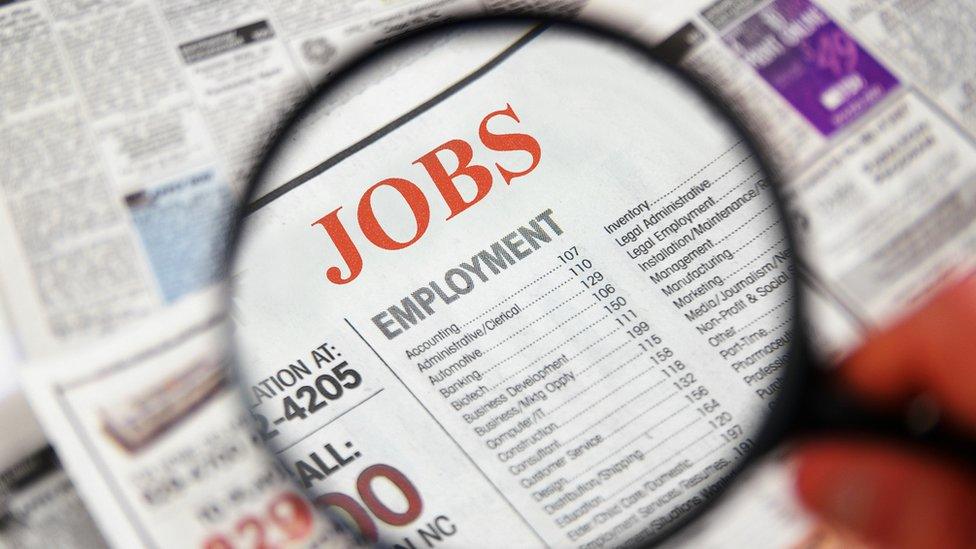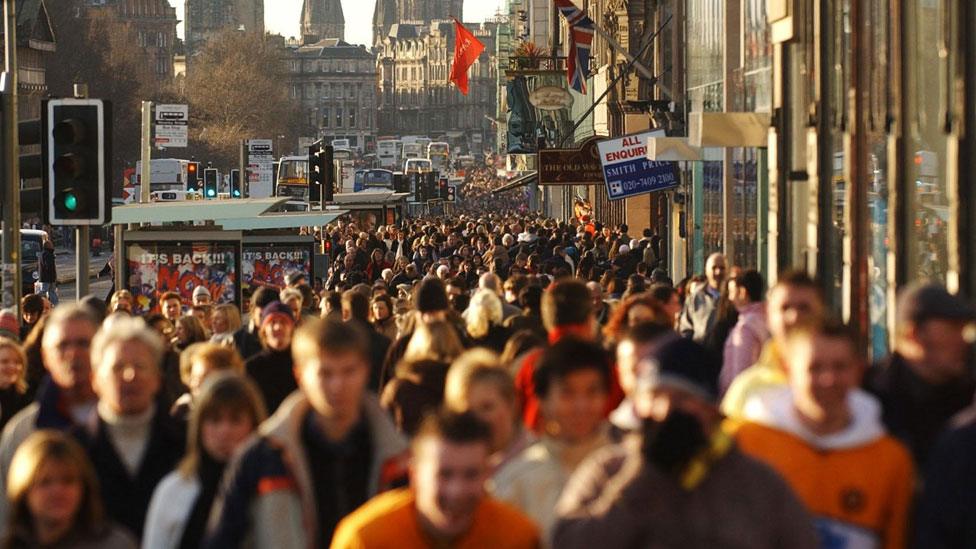Scottish unemployment sees further fall
- Published

Unemployment in Scotland fell by 25,000 over the summer, according to the latest official figures.
The Office for National Statistics (ONS) said the rate between June and August had fallen to 4.6%, below the figure for the UK as a whole at 4.9%.
This left the number of jobless people in Scotland at 127,000.
However, employment rates also decreased slightly, down 0.1 percentage points to 74%, meaning there were 2,618,000 people in employment.
Across the UK, the jobless total rose by 10,000 - reaching 1.66 million.
The UK government welcomed the Scottish figures and said that unemployment was now at its lowest level since 2008.
'Falling again'
The Scottish government said Scotland was outperforming the rest of the UK on unemployment, female employment, and inactivity rates.
They said there were 54,000 more people in employment now compared to the pre-recession peak in May 2008.

Analysis: Douglas Fraser, Scotland business/economy editor
The last two months of figures from the Labour Market Survey have seen a sharp change for Scotland's position, from lagging the UK badly to being better than average, on unemployment at least.
The employment rate remains lower than the UK level. And the category that explains that apparent discrepancy is the "economically inactive".
These are people who respond to the survey they are neither in work nor available for work. Quarter are in full-time education. Quarter are looking after family, and more than a fifth are ill long-term.
But the puzzling bit about the most recent figures is how fast the number of economically inactive people - and women, in particular - has been rising.
In the past year, 34,000 working-age (16-64) women have left the labour market, to reach 462,000. That's an 8% increase. The fastest rise has been in the most recent quarter, up 5%.
The UK figure has gone down. Scotland's inactivity, for both men and women, runs at 22.5% and the UK's at 21.3%. So not a big difference, but the figures have been going in opposite directions over the past year. Only south-west England has seen a rise like it.
Why? The figures don't tell us. And nor do any of the other surveys of the Scottish economy.

Minister for Employability and Training, Jamie Hepburn, said: "Despite continuing economic concerns following the EU referendum result, these latest statistics show our policies and investment are helping to reduce unemployment.
"We will not be complacent and are absolutely committed to taking action to tackle inequalities and increase employment rates."
The UK Secretary of State for Scotland, David Mundell, said it was worrying that employment had fallen and that more people were dropping out of the labour market in Scotland when the numbers in the rest of the UK were up.

He added: "The levers to shape the Scottish economy are there for the Scottish government to pull. They need to start focusing on the day job and how they can use their new powers to support the Scottish economy.
"Because these are not just statistics - behind the fall in employment and rise in economic inactivity are thousands of people in Scotland who deserve the security and opportunity that a job brings."
Liz Cameron, chief executive of the Scottish Chambers of Commerce, said the Scottish government needed to invest in skills to raise productivity.
She said: "These latest figures present a mixed picture of the Scottish economy.
"The large fall in unemployment is good news but overall levels of employment in Scotland have fallen, economic inactivity is rising, as has the number of those claiming benefits.
"Against a background of Scottish economic growth which has lagged below overall UK growth levels since April 2015, it is clear that challenges remain to be addressed, including the need to grow Scotland's productivity, which remains low by international standards."
'Brexit uncertainty'
The Federation of Scottish Business called on ministers to think first about the impact on small firms and local economies when they were making key decisions.
Andy Willox, the organisation's Scottish policy convenor, said: "We absolutely want the impact on local business to play a pivotal role in the upcoming Brexit negotiations.
"But this principle must also be applied much closer to home, especially in relation to the upcoming Autumn Statement and Scottish government budget."
The Scottish Trades Union Congress said the figures showed that there were 34,000 more women economically inactive than at this time last year.
General secretary Grahame Smith added: "With already weak growth and the impact of lower investment post-EU referendum yet to become apparent, the STUC is sceptical that the Scottish labour market will improve through the remainder of 2016.
"A major concern for next year is that real wages will once again start to fall as inflation picks up and wage settlements reflect pre-Brexit uncertainty.
"In these circumstances it is essential that the chancellor uses next month's autumn statement to stimulate jobs and growth."
Scottish Labour's economy spokeswoman Jackie Baillie said the rise in economic inactivity was concerning.
She added: "There are many reasons for economic inactivity, including studying and looking after family members, but the data shows that 190,000 Scots want a job.
"Women in particular appear to be struggling as a result of the economic problems facing our country."
- Published17 August 2016
